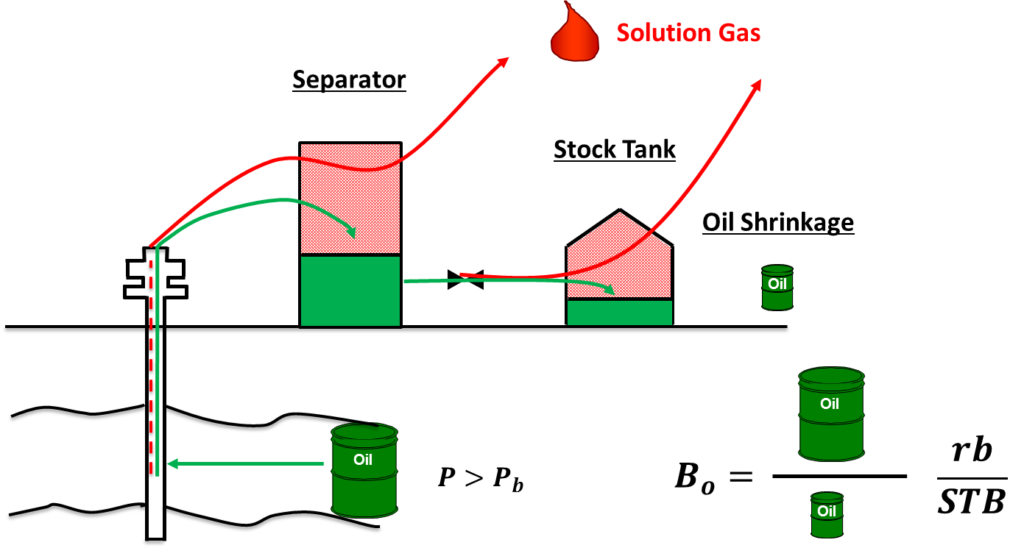Back to: General Petroleum Engineering
The produced volumes measured at surface conditions are never equal to the volumes at reservoir conditions because of the differences in temperature and pressure. In order to carry out meaningful reservoir engineering analysis (such as material balance!!) and size pipelines upstream, it is important to understand how the volume of a fluid changes from the reservoir to the surface. As reservoir oil is transported to surface three things occur:
- Gas comes out of solution, therefore the oil loses mass
- The fluid contracts because the surface temperature is cooler than the reservoir temperature
- The fluid expands because the pressure decreases from reservoir pressure to atmospheric pressure
We often neglect contraction due to temperature changes because it is very minor. The figure below illustrates what happens to oil as it is transported from reservoir to surface conditions for an undersaturated reservoir (i.e. reservoir where the pressure is above the bubble point):

From the figure above it is clear that the oil volume at the surface shrinks relative to the reservoir volume. This shrinkage can be accounted for by introducing a ratio known as formation volume factor ![]() . The formation volume factor is defined as the oil liquid volume at reservoir conditions divided by the oil liquid volume of the same sample at surface conditions. So why does the oilfield volume shrink as it rises to surface?? The short and sweet answer is as the oil rises to the surface, gas comes out of solution. We can see from the figure above, that gas evolves out of the oil and is separated from the oil at the surface. Each time this happens, the oil volume gets smaller and smaller as indicated by the reduced liquid levels above. But In the lab, formation volume factor is measured of an oil sample to collect PVT parameters for material balance and reservoir engineering analysis. The typical shape of oil formation volume factor is illustrate in the figure below:
. The formation volume factor is defined as the oil liquid volume at reservoir conditions divided by the oil liquid volume of the same sample at surface conditions. So why does the oilfield volume shrink as it rises to surface?? The short and sweet answer is as the oil rises to the surface, gas comes out of solution. We can see from the figure above, that gas evolves out of the oil and is separated from the oil at the surface. Each time this happens, the oil volume gets smaller and smaller as indicated by the reduced liquid levels above. But In the lab, formation volume factor is measured of an oil sample to collect PVT parameters for material balance and reservoir engineering analysis. The typical shape of oil formation volume factor is illustrate in the figure below:

The figure above shows how the formation volume factor changes as a function of pressure at constant reservoir temperature. The process can be described in steps:
- 1-2: As the reservoir pressure is decreased from initial reservoir pressure (
 ) to bubble point pressure (
) to bubble point pressure ( ), there is a slight expansion of liquid in the reservoir, thus results in a higher formation volume factor.
), there is a slight expansion of liquid in the reservoir, thus results in a higher formation volume factor. - 2-3: As the reservoir pressure falls below bubble point pressure, gas comes out of solution and the formation volume factor decreases. As reservoir pressure steadily declines, the formation volume factor approaches a value of 1.0.
From the figure above it is clear that there are two distinct regions where we notice significant changes in formation volume factor: 1) above the bubble point and 2) below the bubble point. It is not always practical to have experimental data describing the phase behavior of a reservoir fluid in both of these regions. In these instances, there are reliable correlations to estimate formation volume factor above and below the bubble point. We will go into those later.
“The formation volume factor is defined as the oil liquid volume at reservoir conditions divided by the oil liquid volume of the same sample at reservoir conditions.”
should be
The formation volume factor is defined as the oil liquid volume at reservoir conditions divided by the oil liquid volume of the same sample at surface conditions.
You are right. Thank you sir!